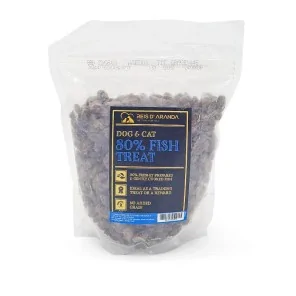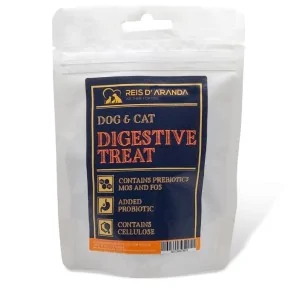Its name says it all: the Vienna blue rabbit comes from Austria. Not only is it beautiful with its shiny blue-grey...
THE KOMONDOR
INTRODUCTION
The Komondor is a breed of guard and herding dog originating in Hungary. Its main characteristic is its striking white or ivory coloured coat, which is long, thick and hangs in long locks reminiscent of dreadlocks or the bristles of some types of mops.
THE ORIGIN OF THE KOMONDOR
Although none of the theories circulating about the Komondor breed are certain, there is one in particular that is better known than the rest, and has come to be taken into account in the research and trials related to the search for the origin of the breed.
This points to migration from Asia. It is believed that the Komondor race accompanied the Magyar tribe when they settled in the Hungarian steppes around the year 900, whose mission was to protect their tribe and community from settlement and to be prepared at all times for combat.
On the other hand, as we have already mentioned, there are other theories that are also known but not fully proven. One of them, in addition to the previous one, is that it was the Mongols who brought the breed, or even that the Komondor is related to the Tibetan dogs found in the Himalayas.
Thanks to the large size and ferocity of the Komondor breed, humans came to involve it in the various tasks and missions of everyday life, highlighting its ability to herd and protect the flock in farm areas.
The owners began to find the Komondor breed an ideal animal for this work, as its padded coat was a great advantage, protecting it from the elements and from the attacks of wolves in the area.
It was precisely for this reason that it was taken to North America to protect the flocks of sheep from coyote attacks. But the most curious thing of all is that nowadays, there are only specimens of the breed left in Hungary, where, due to the climate, they began to take them to the country for a correct adaptation thanks to their dense coat.
WHAT IS THE KOMONDOR LIKE?
GENERAL APPEARANCE: The Komondor is a large and strongly built dog. His outward appearance, that of a winner and his majestic stance arouse respect in the observer and possibly also fear. He is not a sycophant by nature. The sturdy body is covered with long hair, always thick without exception, matted, in tufts.
Seen from the side, the body is a flat rectangle, almost a square.
Protruding above the body is the very thickly furred head. The tail is carried hanging down with the tip bent almost to the horizontal. The coat is ivory coloured.
IMPORTANT PROPORTIONS:
- The length of the body is hardly longer than the height at the withers.
- The depth of the chest corresponds to almost half the height at the withers.
- The muzzle is slightly shorter than half the length of the head.
HEAD : Broad and well proportioned to the body. Even the dense coat covering it like an umbrella does not make it appear disproportionate.
CRANIAL REGION:
SKULL: Arched. The supraciliary arches are well developed.
STOP: Well marked, though not abrupt.
FACIAL REGION:
TRUFA: Straight, abruptly cut and black.
HOCIO: Not pointed. The bridge of the nose is straight.
LIPS: Black. Leaning firmly to the jaws and to the bite. Commissure of the lips is curved.
JAWS / TEETH: Jaws very muscular, strong and powerful. Scissor bite, regular and complete in accordance with the dog's dental formula.
EYES: Set on horizontally, dark brown. The rims of the eyelids are black and rest firmly on the eyeball.
EARS: Set on at medium height on the arched skull. They are directly and distinctly pendant and have a ‘V’ or ‘U’ shape. The ears are not raised during attention or when the dog goes on the offensive.
NECK: Very well muscled. It forms an angle of 35° to the horizontal. In calm and friendly situation it is carried almost in line with the line of the back. Shorter than medium length. Without dewlap and without throatiness.
BODY
TOPLINE: The parts of the body forming the topline are broad and richly muscled.
CROSS: Sufficiently long, well defined in front.
BACK: Short.
LOIN: Medium length.
Croup: Broad, of medium length. Gently sloping.
CHEST: Broad and strongly muscled.
BELLY: Medium deep, broad, long.
BELLY: Slightly tucked up.
TAIL: Set on low, distinctly pendulous; the distal part of the tail is gently curved close to horizontal. It is desirable that the tail should reach to the hock. When the dog is excited, the tail is raised to the level of the dorsal line.
LIMBS
FOREQUARTERS: Judgement of the limbs is greatly impaired through the long, matted coat covering them. The forelegs are columnar and seen both from the front and in profile, straight, parallel and perpendicular to the ground. The chest is broad and lies between the limbs which are set wide apart from each other, robust and free moving. The limbs are firmly attached to the body. The bone structure is strong and powerful. The limbs are bulky.
Shoulders: The shoulder blades are slightly oblique. The upper points of the shoulder blades are placed in a vertical line with the deepest point of the chest.
HANDS: Large, firm, with fingers close together. The pads are slate grey, full and well padded. The nails are grey.
HINDQUARTERS: The hindquarters support the body from moderate angulations. In continuation of the medium length croup, broad and strongly muscled hindquarters.
MUSLE: Powerfully muscled, voluminous.
FEET: The hind feet are longer than or equal to the front feet. Dewclaws should be removed.
GAIT / MOVEMENT: Smooth, free and moderate movement. The gait is wide and with good ground coverage.
COAT
COAT: The body is covered with long hair all over. The coat is composed of an outer coat of coarse hair and a finer undercoat.
The character of the coat is given by the ratio between the outer coat and the undercoat. The coat in tufts and with a tendency to mat is a basic requirement. A similarly dense, wavy and corded coat is also permissible. Small tufts are few or not matted. The coat reaches its maximum length on the rump, in the region of the loin and on the back of the thighs (minimum 20-27 cm.); on the back, on the sides of the chest and in the area of the shoulder blades, it is of medium length (minimum 15-22 cm.); on the cheeks, the supraciliary arches, on the upper region of the skull, on the ears, on the neck and on the limbs, it is shorter (10-18 cm.). The shortest hairs (9-11 cm) are on the flews and under the limbs. Neither combed hairs nor unkept hairs are desirable.
COLOUR: Ivory.
SIZE AND WEIGHT
HEIGHT AT WITHERS
- Males: minimum 70 cm.
- Bitches: minimum 65 cm.
WEIGHT
- Males: 50 - 60 kg.
- Females: 40 - 50 kg.
The breed has few faults of type and is largely homogenous, as it has always been bred for the same purpose.
FAULTS: Any departure from the foregoing points should be considered a fault and the seriousness with which the fault should be regarded should be in exact proportion to its degree and its effect upon the health and welfare of the dog. Specifically:
- Lack of pigmentation of nose, eyes and rims of eyelids.
- Loose eyelids.
- Ringed tail.
DISQUALIFYING FAULTS:
- Aggressiveness or extreme shyness.
- Any dog showing clear signs of physical or behavioural abnormalities.
- Flabby body structure with insufficient musculature.
- Overshot or undershot bite, deviated incisor arches.
- Entropion and ectropion
- Ears light and erect.
- Short tail (3 cm above the hock).
- Heavy limbs and lack of movement.
- Colours different from the admitted colours, coats of various colours.
- Height at withers below the minimum required by the standard.
N.B.:
- Male dogs should have two apparently normal testicles fully descended into the scrotum.
- Only functionally and clinically healthy dogs, with breed typical conformation, should be used for breeding.
TEMPERAMENT: Like most herding dogs, the Komondor is a calm and quiet dog as long as the situation is normal. In case of danger he will bravely defend the flocks in his care, this instinct is also reflected in his family and territory, which he tends to protect. He was bred to think independently and make his own decisions. It is an affectionate dog with the family and gentle with children; although wary of strangers, it will accept them on confirmation that they have no bad intentions. It is a very athletic breed, able to jump and attack any predator in order to drive it away, and has been used successfully to defend herds against bears and wolves.
Because of its size, strength and speed, it is imperative that its owner be able to control it, so it is important to train and socialise the animal to prevent it from developing aggressive tendencies.
THE HEALTH OF THE KOMONDOR
The Komondor is a fairly healthy breed that only suffers from the typical diseases of large dogs (regardless of whether they are purebred or not):
- HIP DYSPLASIA: D ysplasia is a bone disease, congenital, hereditary, degenerative and multifactorial, i.e. it can be caused by multiple factors. For it to appear there must be a genetic predisposition to which other factors can be added, such as poor diet, rapid growth, excessive exercise during growth, growth on slippery ground, obesity, old age and the wear and tear it causes..... Studies are currently underway to determine the genetic predisposition of individuals, however, for the moment the tests are based on the development or not of this disease and not its genetic predisposition. Hip dysplasia consists of the malformation of the hip acetabulum and the femoral head, causing the femur and pelvis to not fit together correctly and causing pain and even lameness in the animal.
- ELBOW DYSPLASIA: Elbow dysplasia consists of the incongruence between the three bones that make up the elbow joint, humerus, ulna and radius, producing collisions and friction that trigger joint alterations causing pain and even lameness in the animal.
- STOMACH TORSION: Gastric torsion in dogs is a very acute condition in which the stomach is rotated around its own axis, usually a turn or a half turn. This compresses the upper and lower mouth of the stomach, preventing the passage of food, gas and liquid.
THE GROOMING OF THE KOMONDOR
As far as grooming is concerned, keep in mind that this breed of dog requires a high level of grooming maintenance:
- The Komondor should not be combed, its strands of hair should be separated with the fingers from time to time. It is necessary to separate each curl or dreadlock from the root, otherwise they will stick together, which changes the appearance of the dog and can lead to problems.
- Bathing them is a complicated task, which can take hours, they must be taken to the groomer's every month and the owners have to work with them at home as well.
- It is vital to take care of their eyes and ears, especially as they are covered by all that fur.
CONCLUSION
The Komondor is recognised by the FCI and belongs to Group 1, which includes herding and driving dogs, with the exception of mountain dogs. The most striking characteristic of the Komondor is undoubtedly its coat. It should be obvious, as it covers most of its body. At first glance, it is easy to confuse the front with the back.
Leave a comment
Log in to post comments
















